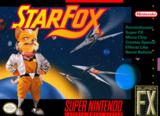One of the defining 16-bit games.
The Starfox team consists of Fox McCloud, Falco Lombardi, Peppy Hare and Slippy Toad, and as a team, they have been sent out by General Pepper to save the Lylat system from the evil monkey scientist Andross, who is planning to enslave the entire galaxy.
Starwing is a shooter, but made unique via the fully 3D graphics. From the outset, you'll have to choose one of three different paths through the Lylat system, each offering different levels, and different difficulties. As with many other shooters, you'll have to simply get to the end by shooting everything down, and then defeating the end of level boss which look truly spectacular in 3D. The controls do take a little while to get used to, as inverted controls are something you never see on the Super Nintendo, but once you get past that little hump, then it'll be smooth flying for the rest of the game. The levels throw various environmental hazards at you, with falling buildings and ship doors to dodge, and these add a further layer of excitement to the game. There are also numerous viewpoints, with one being in the cockpit, and adds a great deal of realism to the game. Finally, in many of the levels, you will be tasked with saving your team mates from enemy chasers, and the better you are at this, the more points you'll get towards another precious continue.
As previously mentioned, Starwing uses 3D polygons as opposed to 2D sprites, and this is one of the cases where new technology actually helps gameplay. The levels are varied, which each one having a distinct look to them, even without any textures on the polygons. The only way that the graphics falter is by the fact that the frame rate can slow down to a snail's pace in the most hectic part, but this is understandable.
Starwing maintains its futuristic setting with a mixture of bleeps and blips, which are indicative of the world the game is set in. The little bits of digitized voice and little quips from your allies go along way to making the levels feel lively.
There are three different routes when you play Starwing, which increases the replay value greatly. The game is a real challenge on the later stages and difficulties, and by the end, you'll feel like you'll have really done something once you have put that damned monkey to sleep!
Closing comments: Starwing is great fun to play, and looks absolutely stunning for a game on the humble Super Nintendo, and just goes to show how much better a console it could be than the Megadrive.

